Optical coherence tomography has proved its worth in the physician’s office, but now it wants to make inroads into the surgical suite as well – and possibly beyond.
Optical coherence tomography, or OCT, is a rapid, noncontact, noninvasive imaging method that allows precise examination of fine layers of tissues. Although it can be used for dermatological purposes, it most often is associated with ophthalmology because it efficiently shows the details of various structures within the eye, including the retina. Modern instruments provide an axial resolution of better than 5 µm and a scanning rate of higher than 20 kHz.
Developed in the 1990s, the first OCT instruments were time-domain imagers. They required a scanning mirror, which reduced their potential resolution and slowed the overall imaging process. The more recent development of spectral-domain OCT (SD-OCT) has brought about higher speed and resolution because no scanning mechanism is needed. The spread of OCT devices, including SD-OCT, has been slowed somewhat by the overall expense and cumbersome size of the equipment, despite generally enthusiastic reviews from ophthalmologists. Now, however, some companies are making smaller devices and even handheld units, which have made it possible to think about including the technique during eye surgery.
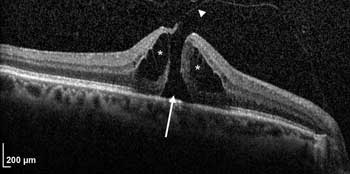
Spectral-domain OCT (SD-OCT) indicates a full-thickness macular hole (arrow) in the retina. Asterisks indicate cystic spaces surrounding the hole. Triangle shows site of vitreomacular traction. Courtesy of Paul Hahn, Duke University.
The use of OCT in evaluating retinal disease and glaucoma has become routine, according to Paul Hahn, MD, PhD, of Duke University Eye Center in Durham, N.C., and his colleagues.
“OCT has quickly revolutionized clinical ophthalmology, initially in the diagnosis of conditions such as macular edema (thickening of the retina, which can be difficult to see during a clinical exam) and now in predicting visual outcomes,” Hahn said. “OCT has become the gold standard for diagnosis of many retinal conditions, and retina specialists generally rely primarily on OCT for routine diagnostic imaging.”
Furthermore, the technology is used frequently to examine nontraditional portions of the eye, including features in both the anterior and posterior segments of the orb, and it is being considered for use by ophthalmological surgeons. Real-time imaging, which would be a powerful tool for surgeons, remains in development.
“Clinical OCT has revolutionized the ability to diagnose surgical retinal conditions, including macular holes, epiretinal membranes and vitreomacular traction,” Hahn said.
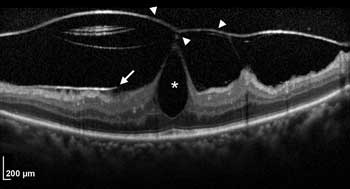
Without OCT imaging, detecting many kinds of eye damage was very difficult. Here, vitreomacular traction caused by the vitreous (triangles) putting traction on the fovea is shown, with a resulting large cystic space created in the retina (asterisk). The arrow points to an underlying epiretinal membrane. Courtesy of Paul Hahn.
SD-OCT in particular could be useful for evaluating a patient’s condition moments before an operation, as well as for testing the results immediately afterward.
Besides diagnosis, Hahn noted, OCT can provide important prognostic information not available to other forms of examination. For example, disruption of the junction between the inner and outer segments (IS and OS) within a patient’s eye may indicate a poorer visual outcome following surgery. The IS-OS junction is a subtle band visible only via SD-OCT and not upon clinical examination.
“I don’t think anyone would have predicted that OCT would yield this type of prognostic information; indeed, the IS-OS junction, previously anatomic trivia for an ophthalmologist, is now part of a retina specialist’s daily vocabulary,” Hahn said.
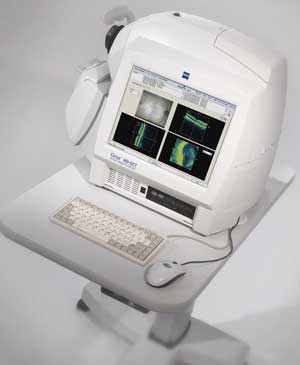
OCT instruments, such as Carl Zeiss Meditec’s Cirrus, are gaining in imaging power, while shrinking in size. Even smaller handheld devices are bringing OCT benefits to patients unable to remain still for traditional OCT imaging. Courtesy of Carl Zeiss Meditec.
Dr. Alexander C. Walsh, director of the Doheny Imaging Exploration and Software Engineering Laboratory at Doheny Eye Institute in Los Angeles, agrees that OCT use has grown quickly.
“Doctors have traditionally considered OCT to be a secondary diagnostic modality to be used after a slit lamp biomicroscope,” he said. “But as we discover that OCT can see more than the naked eye in most cases, it now seems appropriate to consider using OCT as a primary diagnostic modality.”
Expanded adoption of the technique also will require OCT makers to create systems that image the tissues between the front and back of the eye, which are a critical part of a complete eye exam, he added.
Intraoperative use of OCT has applications in the visualization of structures during surgery, and Hahn’s group at Duke University is using it to identify novel morphological features of the eye that may help doctors predict visual prognosis.
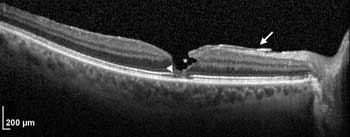
Disruptions in the junction between the inner and outer segments of the retina (indicated by triangle) are impossible to see during a visual exam. OCT imaging makes it clear. Arrow is pointing to an epiretinal membrane, while the asterisk indicates a secondary inner lamellar hole. Courtesy of Paul Hahn.
Postoperatively, the successful or failed closure of macular holes, the removal of epiretinal membranes and the relief of vitreomacular traction can be documented definitively with OCT images.
One eye or two?
Standard OCT systems are monocular; that is, only one eye at a time is made available to the optics of the device.
Because early OCT devices were used to examine specifically known problem areas localized to a single orb, this made sense. However, as OCT instruments became more widely used to compare both of a patient’s eyes, or to develop a baseline of health in anticipation of future problems, ophthalmologists began using the devices to take bilateral readings. Eventually, completely binocular systems that could acquire OCT data from a pair of eyes simultaneously came under development.
Binocular systems have the potential not only to reduce the time spent on procedures and the related extra cost, but also to perform several tasks that single OCT cannot, according to the Doheny Eye Institute’s Walsh, who has started a company to commercialize binocular OCT technology that he has developed.
Walsh said that adding smartphonelike brains to a binocular OCT system could make OCT an all-purpose visual health system. Such evolved systems could, for example, function as refractometers and slit-lamp microscopes. They also could be used to perform visual field tests, acuity tests, pupillometry (pupil size measurements) and even intraocular pressure (IOP) tests.
“We are building our system to perform all of these tests right now,” Walsh said. “Although no one has tested a ‘smart’ OCT system in [the] clinic, many people have already tested smartphones and iPads ... specifically testing of visual acuity, Amsler grid testing, visual fields and auto-refraction.”
Inside Walsh’s binocular OCT system are a pair of smartphones, which help perform all of these tests and more.
“The hardest ones will be autorefraction and IOP testing, but we still have high confidence that these are possible – and may be more accurate than any existing device,” he said.
On-hand power
Compared with standard OCT systems, handheld devices allow for mobile imaging without positioning constraints. The former requires that patients be held still in a seated, upright position – not appropriate for surgical use, for patients who can’t remain in an upright position comfortably, or even for fidgety younger patients.
Bioptigen Inc. of Research Triangle Park, N.C., started the handheld field just five years ago, with a device that can scan from any angle. It was designed primarily for patients unable to sit still upright, especially children, but now has even been used by veterinarians on animal patients (see sidebar).
The biggest hurdles stymieing rapid adoption of handheld units are their cost – because of their comparative rarity – and training operators to get full use of the instrument. Training technicians to use full-size equipment has become old hat for the most part, but the new handheld systems present a slightly different challenge. The latter systems require precise alignment to assure good images of specific areas of interest, said Duke University’s Hahn. Furthermore, OCT systems with integrated microscopes are in the prototype stage and likely will have their own training needs once they progress into commercial availability.
“There is a learning curve to the use of handheld imaging, whose intrasurgical use I predict will be replaced as microscope-integrated systems are further developed,” Hahn said. “I think we will see a growth of intrasurgical OCT within the next five years, but significant technological advances are still required.”
Makers of any size OCT instrument also look to advances in the software that drives the instruments; that is, new ocular diseases can be examined via OCT whenever software updates incorporate novel techniques.
In January, for example, Carl Zeiss Meditec of Jena, Germany, introduced two software-based tools that work with the company’s Cirrus HD-OCT system. One is designed to permit diagnosis of dry age-related macular degeneration (AMD); the other, glaucoma.
For dry AMD, the Cirrus now provides advanced retinal pigment epithelium (RPE) analysis, which tracks changes in RPE elevation area and volume, and identifies and measures the area of transparent regions in the RPE that can develop with geographic atrophy.
Although OCT techniques thus far have focused on retinal imaging in the clinic, the technology’s future is bright for surgical applications. OCT technology is continuously improving, and it is being explored for use in other areas of the eye, such as the anterior segment.
“OCT has obvious implications for corneal surgeons, particularly in identification of different layers of the cornea, and for glaucoma surgeons, particularly in visualization of the angle structures,” Hahn said.
“I think that intraoperative OCT will be incredibly useful in the future,” Walsh said. “I have high hopes for functional OCT (measuring tissue function directly with OCT instead of using surrogate tests like we’re doing with our ‘apps-driven’ platform).”
He added that self-operated OCT could be on the way and could become more important as insurance reimbursements for OCT drop.
“We want to begin moving health care into the home,” he said. “It would be tremendously useful if my patients could capture OCTs of their own eyes and send them to me to determine if they need to come in. That could both improve care and reduce costs if we can do it safely and effectively. To do this, OCT systems will need to get smaller, cheaper and better. And they are.
Handheld OCT Just Right for the Vet’s Tool Kit
Late last year, veterinarians for the first time used a handheld spectral-domain optical coherence tomography (SD-OCT) system to help remove a cataract from a nontraditional patient – C’sar the elephant.
The middle-aged animal, who has lived at the North Carolina Zoo in Asheboro since his birth in 1974, had been confined to a small barn and paddock after cataracts in both eyes blinded him in March 2011, preventing him from being able to graze freely within the 3.5-acre savannah on the zoo grounds.
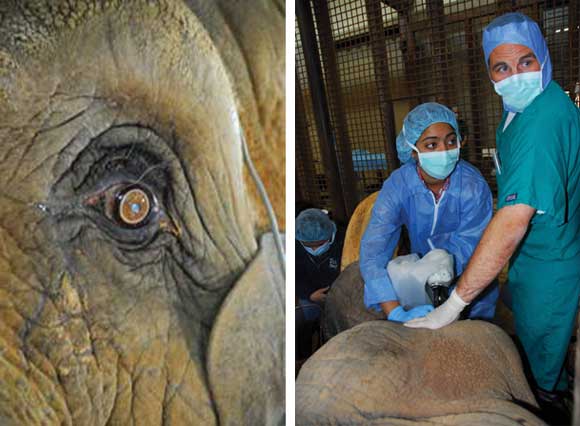
The surgeons used the Envisu R2300, a handheld SD-OCT imaging system made by Bioptigen Inc. of Research Triangle Park, N.C. The device allowed them to visualize layers of the cornea, the cataract and the lens capsule prior to surgery.
Dr. Richard J. McMullen Jr., an assistant professor of ophthalmology at the College of Veterinary Medicine at North Carolina State University in Raleigh, performed the operation.
“The biggest difference between OCT and ultrasound is the amount of detail you can see in the cornea, especially within the stroma and epithelium,” he said following the four-hour procedure. “As a surgeon, it was very interesting and useful to have that degree of magnification.”
The surgery marked only the fifth time that cataracts had been removed from an elephant, and it was the first time that an SD-OCT system was used on an elephant. The surgery was successful, and C’sar’s handlers reported that his behavior improved dramatically immediately after surgery. As of last month, C’sar was allowed to roam freely once again, and he has had no problem finding his way around the territory.